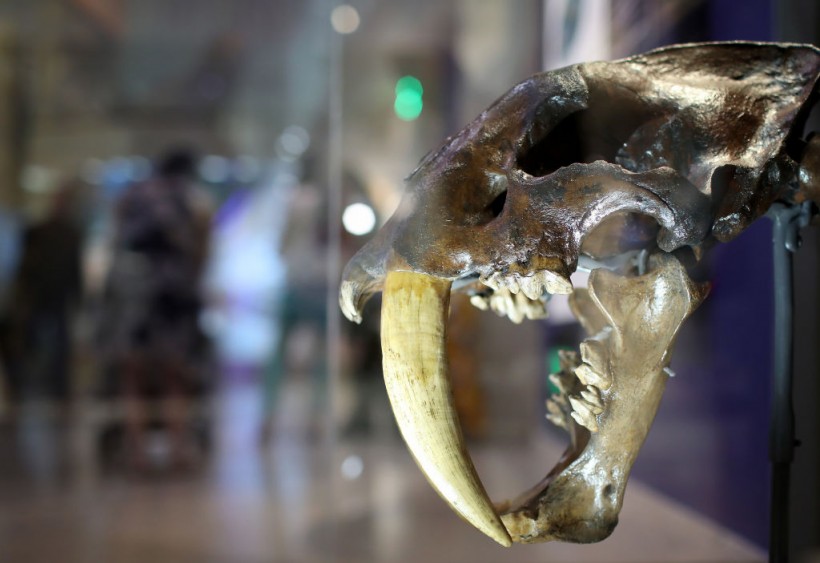Experts recently found how the diverse species of the prehistoric saber-toothed predators, particularly the feline group, looked like in the past. Among the focus of the study was to identify the form of their fangs when they are at rest from hunting.
Stereotypical Illustrations of Saber-Tooth Cats Might Be Wrong

WASHINGTON, DC - JUNE 04: A saber-tooth cat fossil is displayed during a press preview of the Smithsonian's National Museum of Natural History’s newly reopened “David H. Koch Hall of Fossils – Deep Time” exhibit on June 4, 2019, in Washington, DC. More than 700 fossil specimens, including mammals, reptiles, plants, and insects, are on display in the hall, made possible by a $35 million gift from billionaire David Koch.
The fossils of saber-tooth felines in the early days of our planet are considered one of the greatest finds ever to be discovered in our age. These giant cousins of modern cats are always pictured in most scientific books and pop culture, with giant fangs sticking out their mouths.
The portrayal of these large faunas has been consistent throughout history since it was first unearthed. It was believed that the couple of enormous teeth from the saber-toothed felines are still noticeable even if their mouths are closed.
In a new study, this popular belief was debunked. Among the vast species of saber-tooth cats, experts investigated one of the groups considered to have been the most widespread across the planet's history.
Homotheirum latidens are saber-toothed felines that represent most of the massive cat groups. However, the artist's impressions in many educational pieces might not be what they look like.
These cats are often interpreted with a couple of pointy teeth even when they are not on the attack. The findings from this new research, on the other hand, verify that the deadly weapons of the big prehistoric cats are hidden when not in predatory use.
Museo Nacional de Ciencias Naturales-CSIC's paleobiology specialist and author of the study Mauricio Anton explained in The New York Times report that the Homotherium latidens are 'the most powerful saber-tooth cats ever to exist during the Pleistocene period.
ALSO READ: Dinosaur 'Ollie' From Outback Queensland Site Confirmed as Australia's Tiniest Sauropod
Homotheirum latidens have fossil records that confirm their widespread existence approximately one million years ago during the Pliocene epoch. Most of their factions were scattered throughout the southern regions of the African continent, the Eurasian fields, and even portions of South America.
A separate study previously discovered that their social life is active and uses their cooperation to bring down heavyweight prey like the extinct mammoths in packs.
These cats are very large mammalian faunas. They grow parallel to the size of modern-day lions and could reach a weight of up to 550 pounds or almost 250 kilograms.
Saber-Tooth Fangs are Hidden When at Rest
Anton presented in a 2009 study titled "Soft tissue reconstruction of Homotherium latidens (Mammalia, Carnivora, Felidae). Implications for the possibility of representations in Palaeolithic art" that the tip of the Homotherium's teeth are visible even if they are at rest. This indirectly supported many stereotypes of saber-toothed felines.
But in an observation carried out in 2016, Anton noticed a valuable characteristic that happens when large cats move their mouth. The expert saw a lion yawn and identified that its lower lip contracts when it closes its mouth. Just before the mouth fully closes, the lower lip envelops the tip of their sharp canine, which commonly scales to 1.5 inches long.
The team used this data and other monitoring information to compare the possibly similar behavior of the modern-day felines to saber-tooth cats. A Homotherium latidens fossil excavated in Perrier, France, was scanned for this association.
The experts concluded that, although the lion's soft tissue and lower lips are not the same as the Homotherium, the mouth of prehistoric cats had a room that could fit and hide their massive fangs, particularly behind the covered part of their jaw.
The authors said that further studies must be added to identify the exact looks of other saber-toothed feline species, as the Homotherium latidens' three-inch upper canines do not apply to every cat individual. For example, a separate species called the Smilodon fatalis have a longer fang that measures up to six inches, making the latest application incompatible with their size.
The study was published in the journal Quaternary Science Reviews, titled "Concealed weapons: A revised reconstruction of the facial anatomy and life appearance of the sabre-toothed cat Homotherium latidens (Felidae, Machairodontinae)."
RELATED ARTICLE: Flying Dinosaur Pterosaurs Confirmed with Feathers, Strands Full of Colors
Check out more news and information on Paleontology in Science Times.














